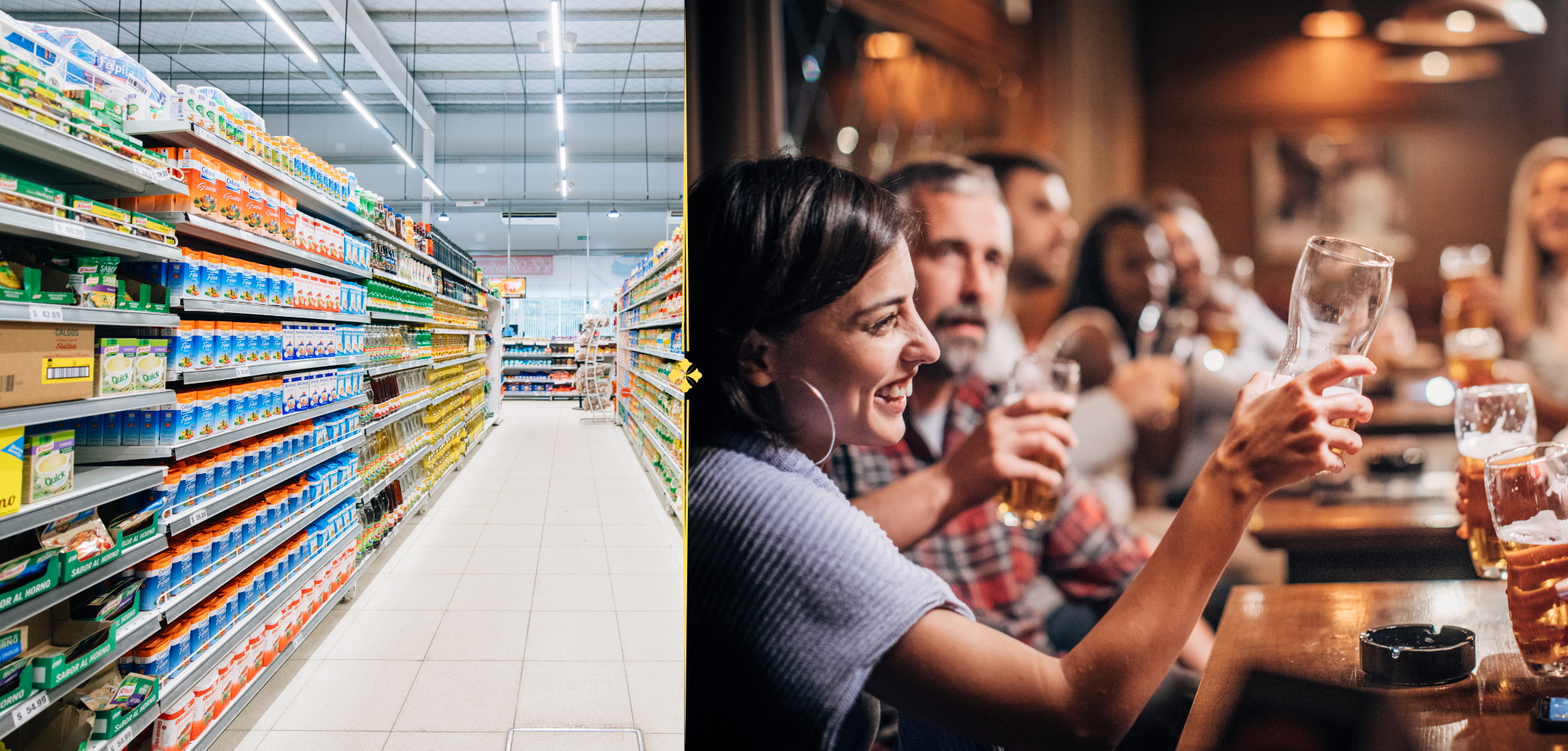On-trade vs off-trade: What’s the difference?


The beverage industry is divided into two main channels: on-trade and off-trade. The on-trade refers to places that sell beverages for immediate consumption on the premises like bars, restaurants, and pubs, while off-trade usually means places like liquor stores, supermarkets and other places where you don’t consume the beverage right away.
While the sale of beverages is the common thread between the two, the differences in the way they operate are vast. In this article, we'll take a closer look at the on-trade and off-trade channels and how they differ.
Time-limited event: Try a free demo of our Outlet Census Live 2.0 on-trade tool. Get your hands on a tool Coca Cola or Heineken are using
On-trade vs off-trade and the customer experience
The on-trade channel provides a unique customer experience. Customers visit a bar, restaurant, or pub to enjoy the atmosphere, socialize, and relax. The environment is crucial, and the experience is as much about the ambiance as it is about the quality of the drink. In contrast, the off-trade experience is more transactional, and the focus is on convenience and selection.
Different approaches to product selection
The off-trade channel typically offers a broader selection of products. A liquor store, for example, may stock hundreds of different types of beer, wine, and spirits. This is because they tend to have more space to store products and can afford to carry a larger inventory. On-trade places, however, typically have a more limited selection, as they need to be able to rotate their stock quickly.
On-trade is pricier than off-trade (for the consumer)
The price of any kind of drink can vary significantly between the on-trade and off-trade channels. Just compare the price of a pint of beer or a can of soda in your nearest store and pub or a high-end bar and see for yourself.
On-trade places often charge more for drinks than off-trade retailers, as they need to cover the costs of operating a physical location and paying staff. However, off-trade retailers may charge more for individual bottles or cans, as they don't have the same overhead costs but need to make a profit on each sale.
It’s true that people may save money by purchasing beverages or meals from a supermarket or liquor store. However, the on-trade channel may offer higher-end products that are not available in off-trade stores, and consumers may be willing to pay a premium for the experience of enjoying these products in a bar or restaurant. The atmosphere and experience of an on-trade venue are often the main draws for consumers who want to enjoy a night out or celebrate a special occasion.
On-trade vs off-trade in the world of regulations
There are different regulations governing the on-trade and off-trade channels. These are specific for each country, state or even city, but there are some similarities.
On-trade establishments, for example, are subject to licensing laws, which vary by jurisdiction. They are also responsible for handling drunk or otherwise intoxicated people, checking for IDs to prevent underage drinking and so on.
Off-trade retailers are also subject to these laws such as minimum age requirements, limits on the amount that can be purchased, and restrictions on when and where alcohol can be sold, but they don’t usually deal with drunk people misbehaving at their stores (although it occasionally happens).
Tricky logistics of the on-trade & off-trade channels
The logistics of the on-trade and off-trade channels differ significantly. On-trade establishments need to ensure that they have enough stock to serve customers, but not so much that it goes to waste. They may also need to order products more frequently to keep up with demand. Off-trade retailers, on the other hand, need to keep a larger inventory of products and may need to manage multiple suppliers to ensure they can keep products in stock.
On-trade employees are seen as experts
On-trade establishments require staff to serve customers, prepare drinks, and manage the business. Staff needs to know quite a lot about the products they are selling to properly market them to customers and answer any questions that might arise. They also need to know their way around regulations concerning the sale of alcohol. Off-trade staff is more focused on managing inventory, restocking shelves, and managing transactions.
From the consumer’s perspective, on-trade staff like waiters and bartenders are seen more as knowledgeable experts, whereas off-trade staff like supermarket employees are not usually treated this way.
On-trade vs off-trade in marketing
Marketing strategies for the on-trade and off-trade channels also differ. On-trade establishments may focus on creating a unique brand experience and building relationships with customers through events and promotions. Off-trade retailers, on the other hand, may focus more on product promotion and price points to attract customers.
If you want to know more about marketing strategies and tactics for the on-trade channel, check out our deep-dive article on this topic.
On-trade marketing strategies and tactics
Different demographics of the on-trade and off-trade channels
The demographics of customers in the on-trade and off-trade channels can also differ. On-trade establishments typically attract a younger demographic looking for a social experience or generally speaking more outgoing kind of people. Off-trade needs to cater to a wider range of ages, including families and older customers. To put it plainly, almost everyone needs to go shopping once in a while.
On-trade vs off-trade: Different opportunities and the role of data
From the buyer perspective, it’s a matter of personal preference. Some might prefer to drink wine or Coca-Cola at home while others can’t imagine drinking alcohol outside pubs or bars as they associate it with socializing. All these differences need to be taken into account by beverage producers as both channels offer unique opportunities but also require different approaches to sales and marketing for achieving maximum efficacy.
If you’d like to know more about the on-trade channel, we have a whole section full of research and other useful knowledge about this topic in 5 languages for you to check out. You can also access free on-trade market data about various beverage brands in our Free Market Report section.
SharpGrid is primarily a company reinventing the on-trade market research. If you’d like to know more about how data collecting, processing and analyzing is changing the world of on-trade, read our article on how the digital revolution changed the on-trade channel or contact us if you’re a beverage producer or data company looking for a potential partnership.
SharpGrid is a data & tech company reinventing market research in the on-trade channel. The on-trade channel consists of POSs (points of sale) like restaurants or bars where food & beverage is bought and consumed, and is often also called HoReCa, on-premise, food service, out-of-home, gastro or immediate consumption (IC) channel, hospitality or on-licence.






